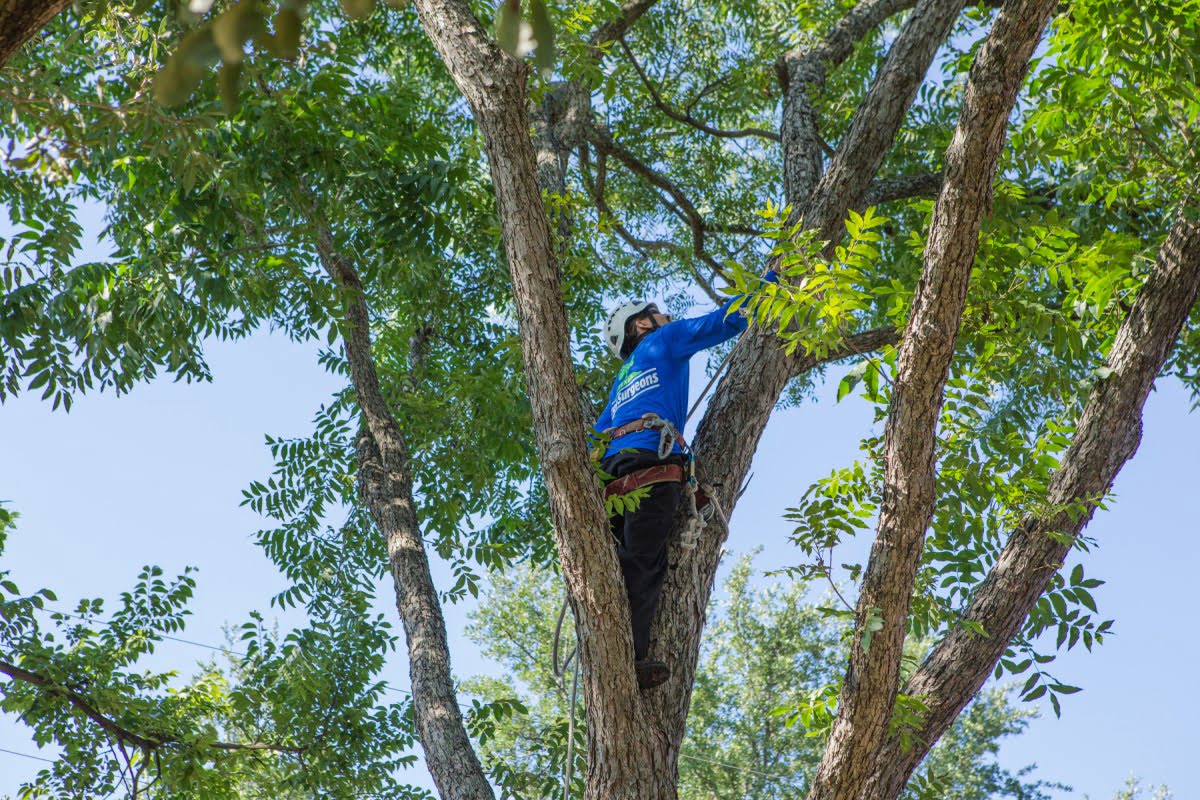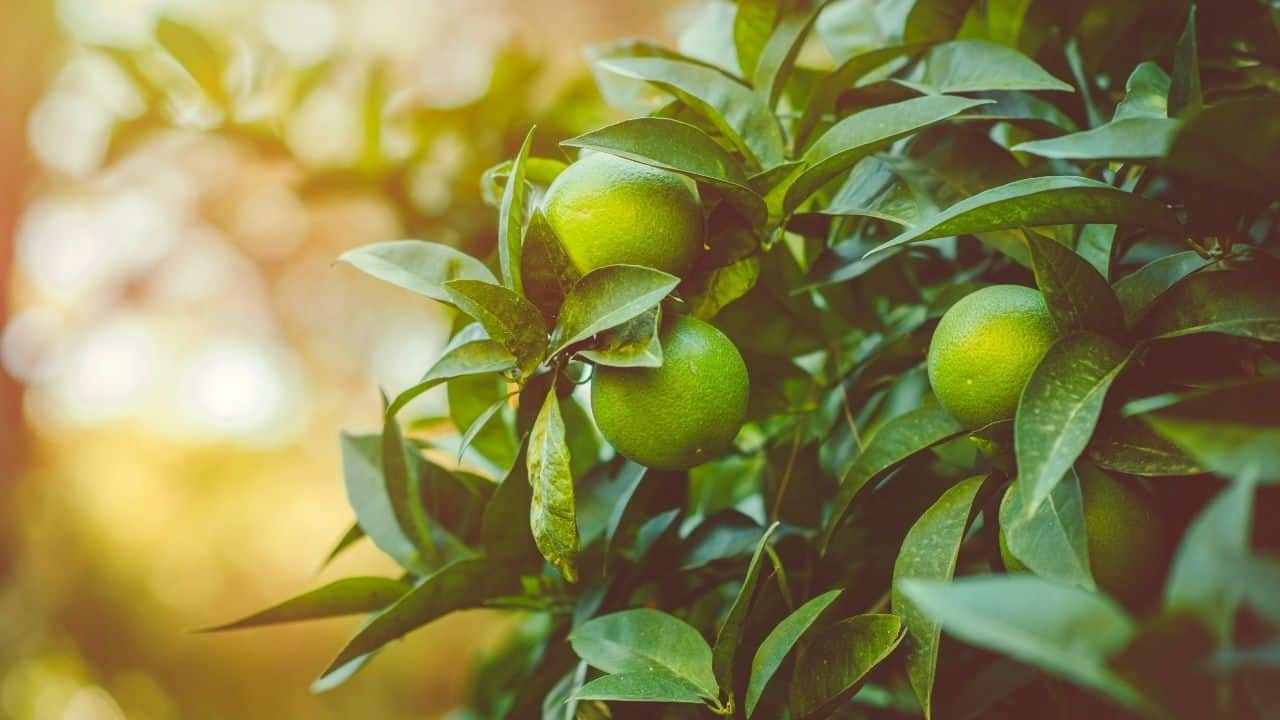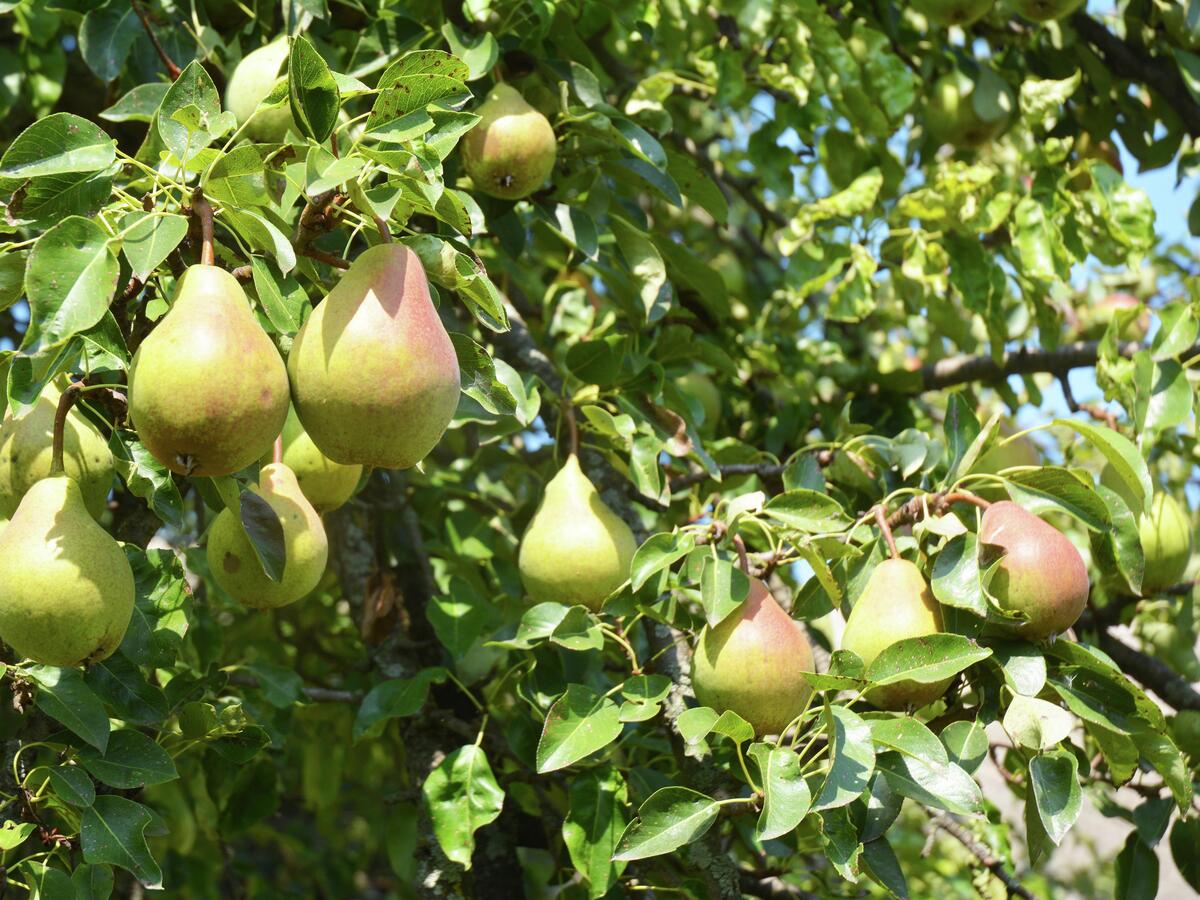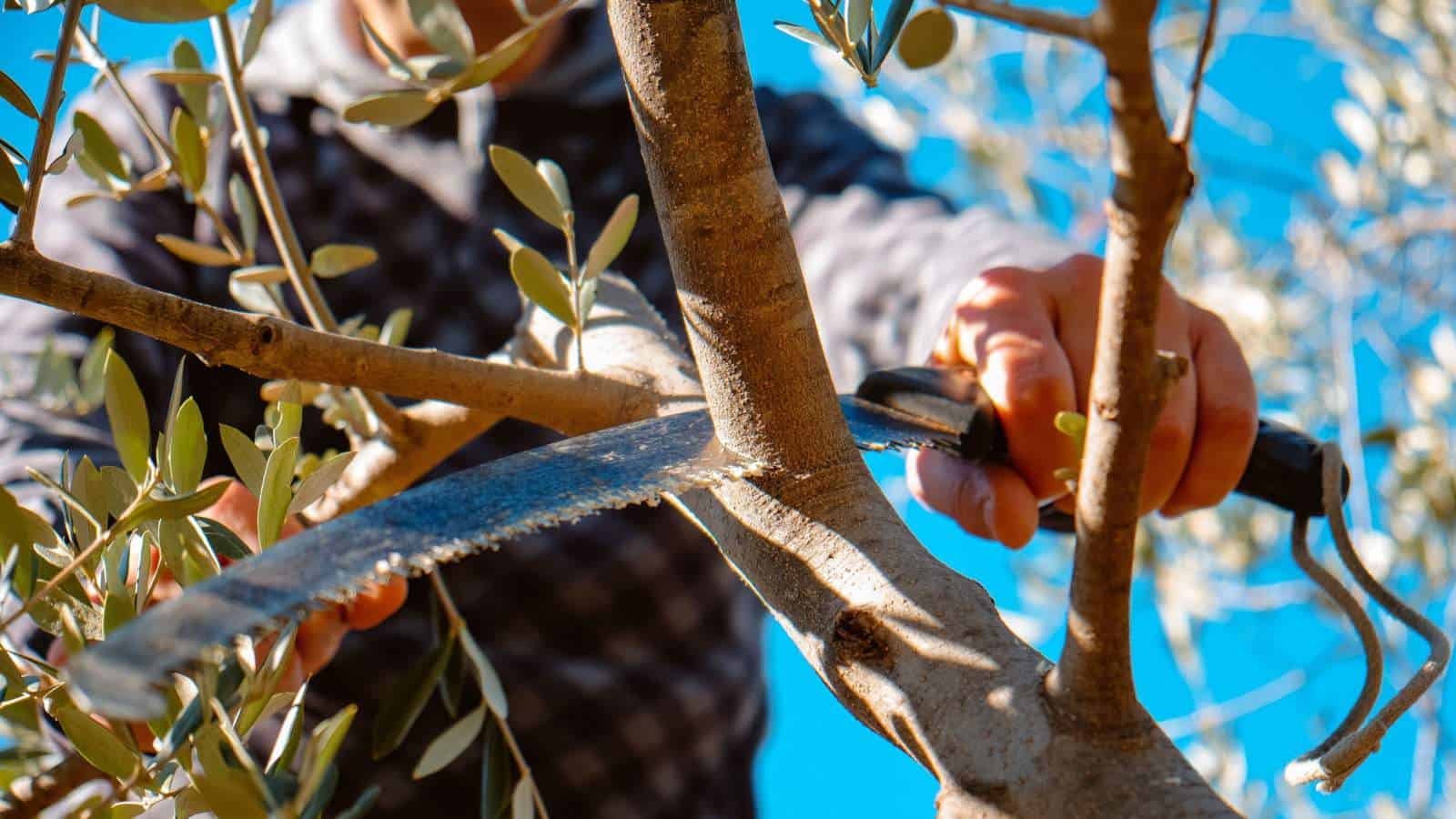Home>Gardening Techniques>Plant Care>When To Trim Pear Trees


Plant Care
When To Trim Pear Trees
Modified: January 22, 2024
Learn when and how to trim pear trees for optimal plant care. Discover the best timing and techniques to promote healthy growth and abundant fruit production.
(Many of the links in this article redirect to a specific reviewed product. Your purchase of these products through affiliate links helps to generate commission for Chicagolandgardening.com, at no extra cost. Learn more)
Table of Contents
- Introduction
- Understanding Pear Tree Pruning
- Factors to Consider Before Trimming Pear Trees
- Best Time of Year to Trim Pear Trees
- Signs Your Pear Tree Needs Trimming
- Steps to Trim Pear Trees
- Tools and Equipment Needed for Pear Tree Pruning
- Pruning Techniques for Pear Trees
- Common Mistakes to Avoid When Pruning Pear Trees
- Conclusion
Introduction
Welcome to the world of pear tree care! Whether you’re an experienced gardener or a plant care enthusiast, it’s important to understand the proper techniques for maintaining the health and appearance of your pear trees. One essential aspect of this is knowing when and how to trim your pear trees.
Pear tree pruning plays a vital role in promoting healthy growth, improving fruit production, and maintaining the overall shape and structure of the tree. By removing dead, damaged, or diseased branches, you can prevent further spread of infections and create a more aesthetically pleasing tree.
Trimming pear trees may seem like a daunting task, but with the right knowledge and techniques, it can be a rewarding and enjoyable experience. In this article, we will guide you through the process of pear tree pruning, covering the best time of year to trim, signs that your pear tree needs trimming, the tools and equipment you’ll need, proper pruning techniques, and common mistakes to avoid.
By the end of this article, you’ll have the confidence and knowledge to confidently trim your pear trees, ensuring their long-term health and beauty.
Understanding Pear Tree Pruning
Pear tree pruning is the process of selectively removing branches and foliage from the tree to shape its growth and promote optimal health. It is essential for maintaining the structure and productivity of the tree while preventing the spread of diseases and pests.
There are several key reasons why pear tree pruning is necessary. First and foremost, it allows for better air circulation and sunlight penetration through the canopy, which helps reduce the risk of fungal diseases and promotes even fruit ripening. Trimming also helps manage the size of the tree, making it easier to harvest the fruits and perform other maintenance tasks.
When it comes to pear tree pruning, there are three primary types:
- Formative Pruning: This type of pruning is done when the tree is young to establish a well-balanced framework of branches. It helps shape the tree’s growth and encourages strong, upright branches.
- Maintenance Pruning: Maintenance pruning is performed on mature trees to remove dead, damaged, or diseased branches. It also involves thinning crowded areas of the canopy to improve airflow and reduce the risk of pest infestation.
- Renewal Pruning: Renewal pruning is a more drastic form of pruning done to rejuvenate older pear trees. It involves removing a significant portion of the tree’s older wood, encouraging the growth of new, productive branches.
Understanding the different types of pruning is crucial as it helps you determine the specific goals and techniques for trimming your pear trees.
Before you start pruning, it’s important to familiarize yourself with the growth habit of your particular pear tree variety. Different varieties have varying growth patterns, such as upright, spreading, or weeping. Understanding how your pear tree naturally grows will guide you in maintaining its desired form and structure.
When pruning, remember that the overall aim is to strike a balance between removing excess growth and maintaining the tree’s natural shape. Over-pruning can weaken the tree and inhibit its ability to produce an abundant crop of delicious pears.
Now that we’ve covered the importance of pear tree pruning and the different types involved, let’s dive into the best time of year to trim your pear trees and the signs that indicate they need pruning.
Factors to Consider Before Trimming Pear Trees
Before you grab your pruning shears and start trimming your pear trees, there are a few important factors to consider. These factors will help ensure that you make the right decisions and achieve the desired results when it comes to pruning your trees.
1. Tree Age: The age of your pear tree is a crucial factor in determining the extent and type of pruning it requires. Young trees, especially those less than three years old, need formative pruning to establish a strong structure. On the other hand, mature trees may require maintenance pruning to remove dead or diseased branches, as well as to maintain their shape and productivity.
2. Tree Health: Before pruning, it’s important to assess the overall health of your pear tree. Diseased or weakened trees may require more aggressive pruning to remove infected branches and prevent further spread of diseases. If you notice any signs of disease, such as cankers, leaf spots, or unusual growth, consult a local arborist or horticulture expert for guidance.
3. Weather Conditions: It is advisable to avoid pruning during extreme weather conditions, such as extremely hot or cold temperatures. Pruning during these times can put additional stress on the tree and hinder its ability to recover. Aim to prune during mild weather, preferably in early spring or late winter before the onset of new growth.
4. Fruit Production: Consider the impact of pruning on fruit production. Pear trees produce fruit on spurs, which are short, stubby branches. When pruning, be mindful of removing too many spurs, as this can significantly reduce the number of fruits produced. Strike a balance between maintaining the tree’s health and structure while preserving its ability to bear fruit.
5. Tree Shape and Aesthetics: Each gardener has their own preferences when it comes to the shape and aesthetics of their pear tree. Consider how you want your tree to look and prune accordingly. Whether you prefer an open-center, central-leader, or modified central leader shape, choose pruning techniques that will help achieve your desired form.
Take the time to evaluate these factors before you begin pruning your pear trees. By understanding your tree’s age, health, weather conditions, fruit production, and desired aesthetics, you can develop a pruning plan that is tailored to your specific tree’s needs. In the next section, we’ll discuss the best time of year to trim your pear trees.
Best Time of Year to Trim Pear Trees
The timing of pruning plays a crucial role in the success and health of your pear trees. Pruning at the right time ensures that the tree has ample time to heal and recover before the onset of new growth. The best time to trim pear trees is during their dormant season, which typically occurs in late winter to early spring.
Pruning during the dormant season has several advantages. Firstly, without leaves, it is easier to see the tree’s structure and identify any dead or diseased branches that need to be removed. Additionally, pruning during this time minimizes the risk of spreading diseases since most bacteria and fungi are less active or dormant.
Timing can vary slightly depending on your specific location and climate, but aim to prune your pear trees when they are still in a dormant state, before buds start to swell or break open. This usually coincides with late winter or early spring when the threat of severe frost has passed.
Keep in mind that pruning too early or too late can have negative consequences. Pruning too early may induce premature growth, leaving the tree vulnerable to frost damage. On the other hand, pruning too late may result in increased sap flow and potential pest infestations.
When pruning your pear trees, focus on removing dead, damaged, or diseased wood, as well as any crossing branches or excessive suckers. Thin out crowded areas to improve airflow and promote better light penetration. Remember to maintain the natural shape and structure of the tree while encouraging an open-centered or modified central leader form to maximize fruit production.
If you missed the dormant season and need to do some minor pruning during the growing season, be cautious. Avoid heavy pruning during this time, as it can stress the tree and inhibit its ability to produce fruit. Limit pruning to removing only necessary branches and adhere to proper pruning techniques to minimize potential harm.
By pruning your pear trees during their dormant season, you can promote healthy growth, improve airflow, and maintain the overall shape and structure of the tree. The next section will explore the signs that indicate your pear tree needs pruning.
Signs Your Pear Tree Needs Trimming
Regular pruning is essential for maintaining the health and appearance of your pear trees. However, it’s important to know when your tree specifically needs pruning to address certain issues. Look out for the following signs that indicate your pear tree requires trimming:
- Dead or Diseased Branches: If you notice branches that appear dead, dry, or discolored, it is a clear indication that they should be removed. Pruning these branches will prevent further spread of disease and allow the tree to focus its energy on healthy growth.
- Overcrowding: When the branches of your pear tree become densely packed, it can hinder proper airflow and sunlight penetration. This can lead to increased humidity levels and the development of fungal diseases. Prune any branches that are congested or crossing to create a more open canopy.
- Branch Damage: Storms, strong winds, or heavy fruit loads can cause branches to crack or break. These damaged branches should be promptly removed to prevent further injury to the tree and reduce the risk of infection.
- Water Sprouts: Water sprouts are rapid vertical growths that emerge from the trunk or the main branches of the tree. These sprouts often lack strength and can weaken the overall structure of the tree. Pruning these water sprouts will help maintain a balanced and sturdy framework.
- Shape Maintenance: Pear trees, like any other tree, require occasional pruning to maintain their shape and desired aesthetic. If you notice your tree becoming unbalanced or losing its desired form, trimming can help restore its natural beauty.
- Low Fruit Production: If your pear tree is not producing an abundant crop of fruits, it may be due to insufficient sunlight reaching the inner branches. Thinning out the canopy by pruning can improve light penetration, leading to increased fruit production.
Regularly inspect your pear tree for these signs throughout the year. It’s crucial to address any pruning needs promptly to ensure the long-term health and productivity of your tree.
Now that you’re aware of the signs indicating your pear tree needs trimming, let’s move on to the practical steps involved in trimming your pear trees in the next section.
Steps to Trim Pear Trees
Trimming your pear trees may seem intimidating at first, but by following a systematic approach, you can successfully prune and maintain the health of your trees. Here are the steps to effectively trim your pear trees:
- Step 1: Assess the Tree: Take a close look at your pear tree to identify any dead, damaged, or diseased branches. Observe the overall shape of the tree and determine which areas need pruning.
- Step 2: Gather the Right Tools: Ensure you have the proper tools for the job, including pruning shears, loppers, a pruning saw, and a sturdy ladder. Check that your tools are clean and sharp to make clean cuts without causing unnecessary damage to the tree.
- Step 3: Start with Deadwood: Begin by removing any dead or diseased branches. Make a clean cut just above the branch collar, the swollen area at the base of the branch, to promote quick healing.
- Step 4: Remove Crossing Branches: Identify any branches that are rubbing against each other, as they can cause wounds and invite pests and diseases. Select the weaker of the two branches and remove it by cutting back to the branch collar.
- Step 5: Thin the Canopy: Thin out crowded areas of the tree to improve airflow and light penetration. Remove branches that grow towards the center of the tree or those that are crossing and overlapping. Aim to create an open canopy that allows sunlight to reach the inner branches.
- Step 6: Maintain a Balance: Step back periodically and assess the overall balance and shape of the tree. Make adjustments by selectively removing branches that may be disrupting the tree’s symmetry.
- Step 7: Prune Suckers and Water Sprouts: Remove any suckers that grow from the base of the tree or water sprouts that emerge vertically from the trunk or branches. These growths divert energy away from fruit production and can weaken the structure of the tree.
- Step 8: Clean Up and Dispose: Once you have finished pruning, remove all the trimmed branches and debris from the area around the tree. This helps prevent the spread of diseases and keeps your garden tidy.
Remember to take breaks as needed and step back often to assess your progress. It’s essential to take your time and make deliberate cuts, ensuring you follow proper pruning techniques. If you’re unsure about any specific cuts or techniques, don’t hesitate to consult a local arborist or horticulture expert for guidance.
Now that you’ve completed the pruning process, let’s move on to discuss the tools and equipment needed for pear tree pruning in the next section.
Tools and Equipment Needed for Pear Tree Pruning
Having the right tools and equipment is essential for successful pear tree pruning. The proper tools will help you make clean cuts and ensure the health and safety of your trees. Here are the essential tools and equipment you’ll need:
- Pruning Shears: Also known as hand pruners or secateurs, pruning shears are a must-have tool for trimming smaller branches and twigs. Look for a pair with sharp blades and a comfortable grip for ease of use.
- Loppers: Loppers are used for cutting larger branches, typically those that are up to 2 inches in diameter. Choose loppers with long handles for increased leverage, and ensure the blades are sharp and can be easily replaced or sharpened.
- Pruning Saw: A pruning saw is necessary for removing thicker branches that are beyond the capacity of loppers. Opt for a saw with a curved blade and coarse teeth for efficient cutting power.
- Pole Pruner: If you have tall pear trees, a pole pruner will come in handy for reaching high branches without the need for a ladder. Pole pruners have a pruning head attached to a telescopic pole, allowing you to make cuts at various heights.
- Ladder: A sturdy ladder is essential for pruning taller trees that cannot be reached with a pole pruner. Choose a ladder that is stable, with non-slip feet, and with a height that allows you to prune comfortably without overreaching.
- Protective Gear: The proper protective gear is important to keep you safe during pruning. Wear safety glasses to protect your eyes from debris, especially when using a pruning saw. Gloves will provide protection for your hands and improve grip while handling tools. Long sleeves and pants will shield your arms and legs from scratches and potential contact with irritants or allergens.
- Disinfectant: It’s crucial to disinfect your pruning tools between cuts and when moving between trees to prevent the spread of diseases. Use a disinfectant solution, such as diluted bleach or rubbing alcohol, and wipe your tools with it before making each cut.
- Tool Maintenance Kit: Keep your pruning tools in optimal condition by having a tool maintenance kit. This may include a sharpening stone or file, lubricating oil for the pivot points, and a brush or cloth for cleaning the blades.
Having these tools and equipment readily available will ensure that you can efficiently and effectively prune your pear trees. Remember to always follow safety guidelines when using pruning tools to prevent accidents and injuries.
Now that you’re equipped with the necessary tools, let’s move on to the proper pruning techniques for pear trees in the next section.
Pruning Techniques for Pear Trees
Pruning pear trees requires careful consideration and proper techniques to ensure the health, productivity, and aesthetics of the tree. Here are some essential pruning techniques to keep in mind:
- Make Clean Cuts: Always aim for clean, smooth cuts when pruning. Use sharp and clean pruning tools to avoid damaging the branches or bark. Make cuts just above the branch collar, the swollen area at the base of the branch, without leaving stubs.
- Remove Dead, Damaged, and Diseased Wood: Start by removing any dead, damaged, or diseased branches. These branches can serve as entry points for pests and diseases, so removing them helps maintain the overall health of the tree.
- Thin the Canopy: Thin out crowded areas of the tree to improve airflow and light penetration. Remove branches that grow towards the center of the tree or those that are crossing and rubbing against each other.
- Aim for an Open Center: Encourage an open-centered or modified central leader form to allow sunlight to reach the interior of the tree. This promotes even fruit ripening and reduces the risk of fungal diseases.
- Manage Water Sprouts and Suckers: Remove any water sprouts and suckers that emerge from the base or along the trunk of the tree. These growths divert energy from the main branches and can weaken the structure of the tree.
- Consider the Fruit Spur: Pears produce fruit on spurs, which are short, stubby branches. When pruning, be mindful of preserving these spurs to ensure a bountiful harvest. Avoid removing too many spurs, as this can significantly reduce fruit production.
- Step Back and Assess: Throughout the pruning process, step back from the tree and assess the overall shape and balance. Make necessary adjustments by selectively removing branches to maintain an aesthetically pleasing form.
- Follow Proper Timing: Prune your pear trees during their dormant season, typically in late winter to early spring, before the onset of new growth. Avoid pruning during extreme weather conditions or when the tree is actively growing, as this can cause undue stress to the tree.
Keep in mind that each tree is unique, and the specific pruning needs may vary. Understanding the growth habit and desired shape of your particular pear tree variety will guide you in making informed pruning decisions.
Lastly, it’s important to note that pear trees may require different pruning techniques depending on their specific age and variety. Consult horticulture experts or arborists for additional guidance and advice tailored to your specific pear tree’s needs.
Now that you’re equipped with the knowledge of proper pruning techniques, let’s explore some common mistakes to avoid when pruning pear trees in the next section.
Common Mistakes to Avoid When Pruning Pear Trees
Pruning pear trees may seem straightforward, but there are several common mistakes that can negatively impact the health and productivity of your trees. Avoid these common pruning mistakes to ensure the best results:
- Over-Pruning: One of the most common mistakes is over-pruning, where too many branches are removed, leading to weakened tree structure and reduced fruit production. Remember to strike a balance between maintaining the tree’s natural shape and removing excess growth.
- Pruning at the Wrong Time: Pruning at the wrong time can disrupt the tree’s natural growth cycle. Avoid pruning during the active growing season, as this can stress the tree and delay its recovery. Stick to the dormant season, typically late winter to early spring.
- Using Dull or Dirty Tools: Pruning with dull or dirty tools can result in ragged cuts that are more prone to infection. Ensure your pruning tools are clean and sharp before use. Additionally, disinfect your tools between cuts and when moving between trees to prevent the spread of diseases.
- Removing Too Many Fruit Spurs: Fruit spurs are critical for pear tree fruit production. Avoid removing excessive fruit spurs, as this can significantly reduce the number of fruits your tree will bear. Instead, focus on removing dead, damaged, or diseased wood while preserving the fruit spurs.
- Overlooking Tree Shape and Aesthetics: While the primary goal of pruning is to maintain tree health, don’t overlook the importance of tree shape and aesthetics. Take the time to step back and assess the overall form of your pear tree. Make selective cuts to maintain a balanced and visually pleasing shape.
- Pruning Too Late in the Season: Pruning too late in the season can result in excessive sap flow and attract pests. Aim to finish pruning before the onset of new growth to allow the tree enough time to heal before active growth begins.
- Not Seeking Professional Guidance: If you’re unsure about any aspect of pruning your pear trees, seek professional guidance. Consulting arborists or horticulture experts can provide valuable advice specific to your tree’s needs and ensure the best results.
By avoiding these common pruning mistakes, you can maintain the health and productivity of your pear trees and enjoy the beauty and abundance of fresh, delicious pears.
Now that you’re aware of the common mistakes to avoid, let’s recap the key points and information covered in this article before you embark on pruning your pear trees.
Conclusion
Pruning pear trees is an essential aspect of plant care that promotes healthy growth, improves fruit production, and enhances the overall appearance of the tree. By understanding the fundamental principles and techniques of pear tree pruning, you can confidently maintain the health and vitality of your trees.
In this article, we explored various aspects of pear tree pruning. We discussed the importance of pruning, the different types of pruning, and the factors to consider before trimming. We also learned about the best time of year to trim pear trees and the signs that indicate pruning is needed.
We then delved into the practical steps involved in trimming pear trees, including assessing the tree, gathering the necessary tools and equipment, and employing proper pruning techniques. We also highlighted common mistakes to avoid, such as over-pruning or pruning at the wrong time.
Remember, pruning pear trees requires careful consideration of the tree’s age, health, and growth habit. It is essential to strike a balance between maintaining the natural shape of the tree and removing excess growth while preserving fruit spurs. By following the appropriate techniques and avoiding common mistakes, you can ensure the long-term health and productivity of your pear trees.
If you are unsure about any aspects of pear tree pruning, it is always recommended to seek guidance from local arborists or horticulture experts. These professionals can provide specialized advice tailored to your specific tree’s needs and ensure the best results.
So, grab your pruning tools, put on your protective gear, and embark on the journey of maintaining beautiful and fruitful pear trees. With proper pruning techniques and care, you’ll enjoy the satisfaction of healthy, vibrant trees and a bountiful harvest of delicious pears.










